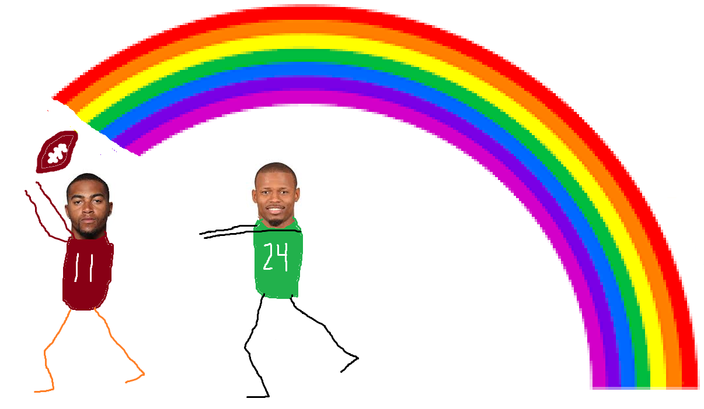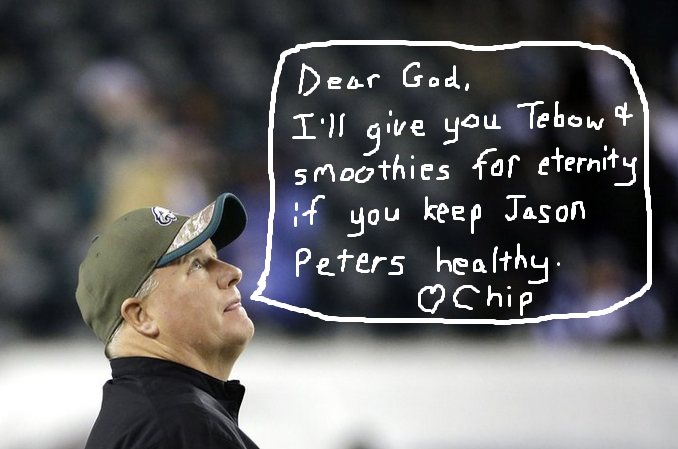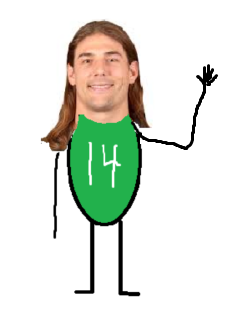
July 21, 2015
Last week we took a vitriolic look at each of the Eagles' divisional enemies, in detail. We blasted the Redskins, busted on the Giants, and poked holes in the Cowboys. Today, (GASP!), we will take a look inwardly at the Philadelphia Eagles. Also to note, this will be published in the Eagles Almanac, which you can pre-order here.
Over the weekend I did some research on Sam Bradford, and it turns out that he tore his ACL. Twice!
After doing some more digging, I learned via several credible sources close to the team that Chip Kelly knew about Bradford's injury history when he traded his existing starting QB, a second round pick and other stuff for Bradford, while taking on his $13 million salary.
Wait... What? Chip knew about this?!?
(OK, steps out of sarcasm character)...
Tim McManus of Birds 24/7 spoke to a doctor, who told him that the chances of Bradford re-tearing his ACL a third time are fairly low:
To get a better understanding for the situation, we spoke with Dr. James L. Carey, Director of the Penn Center for Advanced Cartilage Repair and Assistant Professor of Orthopaedic Surgery at the Perelman School of Medicine at the University of Pennsylvania. From Dr. Carey's vantage point, does the fact that Bradford is coming off two ACL ruptures make it more likely that he will sustain a third?
"No," he replied. "In my opinion, I don't think that he's at an increased risk for a third injury any more so than his other knee or the knees of any other NFL quarterback."
The odds of re-injuring the same knee are relatively low. According to Carey, studies have shown that the probability of re-tearing a reconstructed ACL is about three to six percent. (Those studies were on the general population, not just football players. But they line up with other findings that suggest the chance of a recurrent injury to the same knee amongst NFL players within two years is about five to six percent.) Meanwhile, the probability of tearing the other knee -- or the "native ACL" -- is higher, around nine to 12 percent.
That is reassuring to some degree. However, the concern isn't so much that he'll tear his ACL again. It's more about how effective a player he'll be after having torn his ACL twice.
On a side note, Kelly is really pushing the idea that there's a legitimate quarterback competition between Bradford and projected backup Mark Sanchez. In my opinion, after having invested so heavily in Bradford, the only way Sanchez is beating him out is if Bradford is hurt, or if Bradford is so obviously awful and Sanchez is so obviously good during training camp that Kelly almost has no choice but to start Sanchez.
Orrrrr... Sanchez can just take matters into his own hands:
How Mark Sanchez can win a starting job pic.twitter.com/WFMWGUJ22P
— Jimmy Kempski (@JimmyKempski) June 10, 2015
Since Kelly took over in Philly, the Eagles have had very low time of possession numbers because they probably run the fastest-paced offense in NFL history. Kelly couldn't possibly care any less about time of possession, and I don't fault him for that.
However, his fast paced offense leads to incredibly skewed stats on both sides of the ball. For example, the Eagles' basic offensive stats:
| Category | Stat | Rank |
| Yards per game | 396.8 | 5 |
| Points per game | 29.6 | 3 |
| Rush yards per game | 124.5 | 9 |
| Pass yards per game | 272.2 | 6 |
Pretty freaking good, right?
However, the reality is that the offense was not as good in 2014 as it appears on paper. The offense's numbers were helped incredibly by two very important factors:
1) Again, as noted, the fast pace with which they run allow them to run more plays than any team in the league.
2) The special teams units and defense scored 11 touchdowns, which on paper benefits the offense, but distorts the reality of how they actually scored 29.6 points per game.
A much better measure of how efficient the Eagles' offense and defense has played, which factors out their fast-paced offense are "points per drive," and other drive stats.
Offensively, according to Football Outsiders, the Eagles scored 1.98 points per drive, which was good for 13th in the NFL. That is certainly nowhere near as impressive as the basic numbers above would suggest. Other drive stats:
| Offense | Stat | Rank |
| Yards per drive | 31.43 | 14 |
| Points per drive | 1.98 | 13 |
| Turnovers per drive | 0.174 | 32 |
| INT per drive | 0.104 | 28 |
| Fumbles per drive | 0.070 | 29 |
| Plays per drive | 5.79 | 22 |
| T.O.P per drive | 2:07 | 32 |
In short, the Eagles scored a lot of points and racked up a lot of yards in 2014 because they ran a ton of plays, not because they were actually, you know, efficient. In that respect, Chip Kelly is a better illusionist than Jon Dorenbos.

Now... to be clear, conversely, the defense isn't anywhere near as bad as the basic stats might suggest, but we're focusing on the negatives here.
Speaking of those 11 touchdowns the Eagles scored on defense and special teams a year ago... Yeah, that's not happening again.
The Eagles gave up the third most 20+ yard pass plays in NFL history in 2014. The immediate and obvious rebuttal to that is to say, "Well yeah, but that was because of Bradley 'Under the Rainbow' Fletcher," who of course is no longer with the team.

True, true. Ol' Bradley was certainly a big part of that. But it's not as if the Eagles don't still have serious question marks in the defensive secondary. Opposite Byron Maxwell, the Eagles have a rookie (albeit a promising one) in Eric Rowe competing with a guy who couldn't beat out Fletcher for a starting job a year ago in Nolan Carroll. Meanwhile, at safety, while Walter Thurmond has looked good on the back end in OTAs and minicamp, it's a different world when the regular season begins. Not to mention, Thurmond has played in 2, 12, 2, and 6 games in each of the last four seasons. The secondary still has plenty to prove.
The Eagles cut the oldest (Evan Mathis) and sixth-oldest (Todd Herremans) projected starting offensive linemen in the NFL, and they still have the third oldest projected starting offensive line in the entire league. That's what will happen when you only draft one offensive lineman in three years. Mathis and Herremans were released, even though the Eagles didn't have much in the way of awesome replacements ready to go after their departures.
Allen Barbre looks like a lock to start at LG. Barbre is a 31 year old journeyman with one career start since 2009, and just eight starts over the course of his career. It's anyone's guess who will start at RG at this point, but for the sake of argument we'll call the favorite Matt Tobin, for now. Using Tobin, the OL starters will have almost no experience playing with the guy immediately to their left or right (it isn't any better if you use someone other than Tobin):
| Eagles OL cohesion | Snaps |
| Number of snaps Jason Peters has played next to Allen Barbre | 0 |
| Number of snaps Allen Barbre has played next to Jason Kelce | 0 |
| Number of snaps Jason Kelce has played next to Matt Tobin | 223 |
| Number of snaps Matt Tobin has played next to Lane Johnson | 143 |
It takes a long time for an offensive line to get good at blocking blitz pickups, stunts, twists, etc. The Eagles' offensive linemen will have logged no significant amount of time playing with the guys next to them. That's a problem.
The Eagles have very good players in LT Jason Peters, C Jason Kelce, and RT Lane Johnson surrounding Barbre and (???) at the guard spots, which should help offset any potential issues at guard, however...
As noted above, the Eagles really only have four definitive starters along their OL, with the fifth spot to be determined by hoping someone will step up (as opposed to several decent options battling it out for the job). They are particularly screwed at the tackle positions if they lose Jason Peters or Lane Johnson, seeing as they don't employ a quality reserve "swing tackle."
We'll take Peters, for example. Using the projected starting lineup noted above, here are the Eagles' options if Peters gets hurt:
| If Peters gets hurt... | LT | LG | C | RG | RT |
| Option 1 | Allen Barbre | Gardner/Moffitt/Kelly? | Jason Kelce | Matt Tobin | Lane Johnson |
| Option 2 | Lane Johnson | Allen Barbre | Jason Kelce | Matt Tobin | Andrew Gardner |
| Option 3 | Lane Johnson | Gardner/Moffitt/Kelly? | Jason Kelce | Matt Tobin | Allen Barbre |
| Option 4 | Andrew Gardner | Allen Barbre | Jason Kelce | Matt Tobin | Lane Johnson |
That's not a pretty picture. Obviously, Jason Peters is a great player, and you can basically say, "Well any team will be severely hurt if they lose (name of elite player)." While that is true, you'd prefer to not have your season destroyed because you lost an offensive lineman.

The Eagles led the NFL in total turnovers, INTs, and fumbles lost in 2014. That's "Triple Crown of Turnover Awfulness." Here are all 36 of the Eagles turnovers last year in 35 seconds:
Some view turnovers as luck-driven. In the case of the 2014 Eagles, that was hardly the case. They got poor QB play for the better part of the season, and their skill position players were careless when they ran with the football. Now, many of those players are now gone or may have different roles in 2015, but the #culture of sloppy football on offense has to change.
If you project Jordan Matthews, Nelson Agholor and Josh Huff to be the Eagles' 1-2-3 trio of wide receiver in 2015 (as I do), the Eagles will have the youngest receiver corps in the NFL. In the long term, that's a great thing. However, in the short term, even with Matthews and Agholor being mature beyond their years, there could be some growing pains with this group.
Speaking of wide receivers, somehow Riley Cooper is still on the team.

As the great Heath Evans of NFL Network pointed out, the Eagles will always be a bunch of ringless namby pambies until they sign a fullback.
@Nelson81 Nope....but every SB champ since 2007 has used a FB. It's called toughness. Something your @Eagles team knows nothing about.
— Heath Evans (@HeathEvans44) March 23, 2015
Now, if you'll excuse me, I'll be going into hiding. Thanks.
Follow Jimmy on Twitter: @JimmyKempski